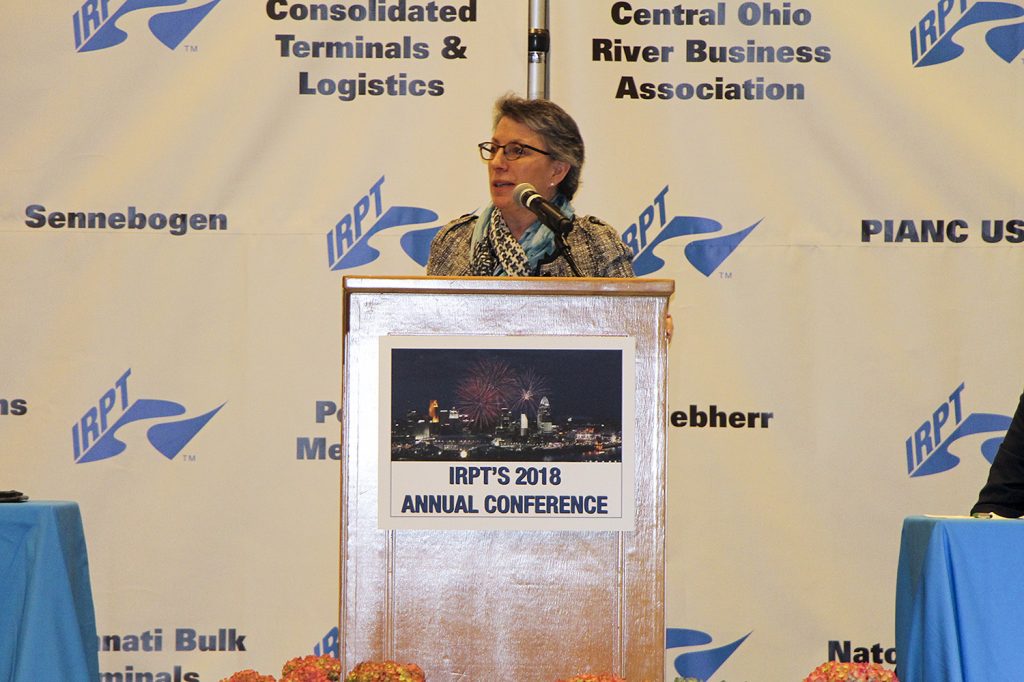NWC Offers Update On Potential WRDA

Amy Larson, president of the National Waterways Conference (NWC), spoke on the possibility of advancing a Water Resources Development Act (WRDA) 2018 this year to the audience of the Inland Rivers, Ports & Terminals (IRPT) conference in Cincinnati, Ohio, April 24.
WRDA bills authorize water infrastructure projects like ports and inland waterways and set policy direction, including such things as streamlining the permit approval process. Over the past four years, WRDA 2014 and 2016 have authorized $14.7 billion in spending for approximately 64 projects.
Both the House and Senate oversight committees—House Transportation and Infrastructure and Senate Environment and Public Works—are expected to unveil their bills in the coming weeks, with mark-up possibly by the end of the month. With that timetable, and the possibility that each chamber could pass its respective bill before the August recess, Larson said NWC is hopeful that agreement could be reached on a final package by the end of the year. She cautioned, however, that passage may depend on the committees’ advancing non-controversial, bipartisan policy changes and minor tweaks to previously adopted provisions that aren’t working as Congress intended.
NWC Hosts WRDA 101 Briefings
To help Congress navigate potential legislation, NWC has developed WRDA 101 briefings, which include a team of experts who have convened in two separate panels to give congressional staff members an overview of why WRDA is important and how they can come together to reach a consensus on the bill under such a tight congressional calendar.
Larson said that the sessions, held for both House and Senate staff, were well attended. “We’re doing what we can to further WRDA along this year despite obvious obstacles,” Larson said. “We’re hoping that because it has bipartisan support, it will cross the finish line this year.”
The WRDA briefings hosted by NWC also provided an overview of the Corps’ civil works program, and discussed the importance of timely WRDAs to authorize the needed studies and projects and provide policy direction to the Corps.
NWC’s team of experts included the Corps’ congressional affairs expert, Jennifer Greer, chief of the Future Directions branch, who was joined by a bipartisan team of former congressional staff members, including John Anderson, vice president at Van Scoyoc Associates and former staff director of the House Transportation and Infrastructure Water Resources and Environment Subcommittee; Charles Brittingham, senior vice president at Cassidy & Associates and the former majority senior water resources policy advisor for the Senate Environment and Public Works Committee; and Ted Illston of Water and Natural Resources Strategies LLC and former senior counsel of the Senate Environment and Public Works Committee.
Larson said the panel was also able to touch upon topics ranging from the importance of working with local Corps districts to resolve issues; the practical challenges of moving legislation, such as WRDA, this year; and the need to get over the finish line by the end of the year.
If WRDA 2018 doesn’t come to fruition until after the midterm elections this fall, Larson said it could be a complete “free for all.” She said House Transportation and Infrastructure Committee Chairman Bill Shuster (R-Penn.), who will not be running for re-election this year, had committed to moving ahead with a new WRDA bill every two years, with the 2018 bill the final one under his tenure.



